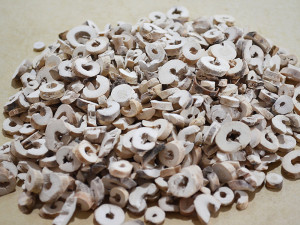Peony is a plant. The root and, less commonly, the flower and seed are used to make medicine. Peony is sometimes called red peony and white peony. This does not refer to the color of the flowers, which are pink, red, purple, or white, but to the color of the processed root.
Contents
Uses
- In Chinese medicine, the root of the red peony is thought to cool the blood, move stagnating blood, and relieve pain.
- Experiments in London, using the tree peony root bark (P. suffruticosa) with other Chinese herbs, successfully treated childhood eczema. It is used to cool the blood, as well as being a good antibacterial for boils and abscesses.
- The root of the white peony has a more specific action than the red, soothing liver energy and improving its function. It is also seen as nourishing the blood rather than cooling it, and is considered to be one of the great tonics for women, often used in menstrual disorders.
- Although rarely used in contemporary European herbal medicine, the peony is thought to be an antispasmodic and sedative used in cases of whooping cough and nervous irritation.
- Suppositories can be made from the root to relieve anal and intestinal spasms.
Benefits
- Peony has been grown throughout the world for medicinal, ornamental, and landscaping purposes. In addition, it is also a nectariferous plant.
- Peony flower is large, colorful, and splendid. That’s why it has always been regarded as a symbol of wealth and good fortune in Chinese culture. What’s more, it is also called “the queen of flowers” and “national beauty with heavenly fragrance.” Nevertheless, it earns such a reputation not by the beauty but the innate pride and dignity. Through a good eye for moutan, being big and showy does not necessarily mean beauty. Instead, what does matter is the attitude – it won’t become conceited with full bloom and impudent with gorgeousness. Above all, the most important thing is its strength of character. It is so proud and unyielding that it refuses to bloom when all other flowers are in full blossom. It doesn’t cater to anyone’s likes and it is always the people who should wait patiently. Perhaps that is the exact reason why it is honored as the queen. As you can see now, what makes peony what it is is its character of fearing no one, especially those in power. No wonder ancient Chinese poets always depict it as a tough fighter.
- Moutan flowers are edible. Now in China its fresh petals are frequently used to make thick soup or garnish other specialty dishes. What’s more, the petals can be used to distill wine. The liqueur made of peony flowers is known for the mellow taste.
- As one of 40 kinds of bulk herbs, it is the main ingredient in a variety of Chinese patent medicine, among which the famous Liu Wei Di Huang Wan (Six Ingredient Pill with Rehmannia) and the relevant series are the biggest source of consumption. And, statistically there are more than 600 pharmaceutical factories, including Beijing Tongrentang, that are producing them. Studies show that its pharmacological and clinical effect is subject to an ingredient called paeonol. That being said, the more peony bark contains paeonol, the better its efficacy it.
Cautions
- Chinese tree peony root bark and paeonol are of lower toxicity. The median lethal dose of paeonol, by intravenous injection, by intraperitoneal injection, and by oral administration, is 196mg/kg, 781mg/kg, and 3430mg/kg respectively after 48 hours. Clinically, a small number of patients may have nausea, dizziness and other adverse reactions after consuming this herb. But stopping medication is not an option here since the above-mentioned symptoms will disappear naturally soon. TCM wise, it shouldn’t be used during pregnancy and in cases of blood deficiency with cold and menorrhagia.
Interactions
- Medications that slow blood clotting (Anticoagulant / Antiplatelet drugs) interacts with PEONY
Peony might slow blood clotting. Taking peony along with medications that also slow clotting might increase the chances of bruising and bleeding.Some medications that slow blood clotting include aspirin, clopidogrel (Plavix), diclofenac (Voltaren, Cataflam, others), ibuprofen (Advil, Motrin, others), naproxen (Anaprox, Naprosyn, others), dalteparin (Fragmin), enoxaparin (Lovenox), heparin, warfarin (Coumadin), and others. - Phenytoin (Dilantin) interacts with PEONY
Peony root might decrease the amount of phenytoin in the body. Taking peony root along with phenytoin (Dilantin) might decrease the effectiveness of phenytoin (Dilantin) and increase the risk of seizures.
Other names
Bai Shao, Chi Shao, Chinese Peony, Common Peony, Coral Peony, Cortex Moutan, European Peony, Jiu Chao Bai Shao, Moutan, Mu Dan Pi, Paeonia, Paeonia alba, Paeonia albiflora, Paeonia anomala, Paeonia arborea, Paeonia arietina, Paeonia beresowskii, Paeonia caucasica, Paeonia corallina, Paeonia coriacea, Paeonia daurica, Paeonia japonica, Paeonia kavachensis, Paeonia lactiflora, Paeonia mascula, Paeonia microcarpa, Paeonia moutan, Paeonia obovata, Paeonia officinalis, Paeonia paradoxa, Paeonia suffruticosa, Paeonia triternata, Paeonia veitchii, Paeonia willmottiae, Paeonia woodwardii, Paeoniae Flos, Paeoniae Radix, Peonía, Peony Flower, Peony Root, Piney, Pivoine, Pivoine Arbustive, Pivoine Blanche, Pivoine Commune, Pivoine de Chine, Pivoine des Jardins, Pivoine en Arbre, Pivoine Moutan, Pivoine Officinale, Pivoine Rouge, Racine de Pivoine, Radix Paeoniae, Radix Paeoniae Alba, Radix Paeoniae Rubra, Radix Peony, Red Peony, Shakuyaku, Shao Yao, Tree Peony, Ud Saleeb, Udsalam, Udsalap, White Peony
References
Source: WebMD, http://www.webmd.com/vitamins-supplements/ingredientmono-32-peony.aspx?activeingredientid=32&activeingredientname=peony
Mdidea, http://www.mdidea.com/products/new/new09406.html
ChineseHerbalHealing, http://www.chineseherbshealing.com/tree-peony/

